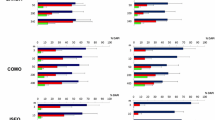Changes of bacterioplankton diversity in lake water were followed in triplicate, continuous-flow experimental tanks. Most probable numbers (MPN) were obtained for 95 different carbon sources using BIOLOG plates and were used to characterize bacterioplankton diversity. During 70 days of incubation, MPN declined for 15 of the 95 substrates while three of 95 appeared to be newly used, indicating functional succession in the bacterioplankton. Total bacterial cell abundance was constant from day 7 to day 70 of the incubation period. The succession of species composition of phyto- and zooplankton was also observed and suggested some involvement by phyto- and zooplankton species in the changes of bacterioplankton diversity. Thus, BIOLOG-based MPN assays is a simple but sensitive method for characterizing the changes in the bacterioplankton carbon utilization profile and is also useful for tracing the functional succession of bacterioplankton diversity within a community.
Similar content being viewed by others
References
Amann R. I. (1995) Fluorescently labelled, rRNA targeted oligo nucleotide probes in the study of microbial ecology. Molecular Ecology 4: 543–554.
Azam F., Fenchel T., Field F. G., Gray J. S. & Mayer-Riel R. A. (1983) The ecological role of water-column microbes in the sea. Marine Ecology Progress Series 10: 257–263.
Bahr M., Hobbie J. E. & Sogin M. L. (1996) Bacterial diversity in an arctic lake: A freshwater SAR11 cluster. Aquatic Microbial Ecology 11: 271–277.
Bernard L., Schaefer H., Joux F., Courties C., Muyzer G. & Lebaron P. (2000) Genetic diversity of total active and culturable marine bacteria in coastal seawater. Aquatic Microbial Ecology 23: 1–11.
Bochner B. R. (1989) Sleuthing out bacterial identities. Nature 339: 157–158.
Choi K.-H. & Dobbs F. C. (1999) Comparison of two kinds of Biolog microplates (GN and ECO) in their ability to distinguish among aquatic microbial communities. Journal of Microbiological Methods 36: 203–213.
Clesceri L. S., Greenberg A. E. & Trussell R. R., eds (1989). Standard Methods; for the Examination of Water and Waste Water, 17th edn. American Public Health Association, Washington D.C.
Fliermans C. B., Franck M. M., Hazen T. C. & Gorden R. W. (1997) Ecofunctional enzymes of microbial communities in ground water. FEMS Microbiology Reviews 20: 379–389.
Gamo M. & Shoji T. (1999) A method of profiling microbial communities based on a most-probable-number assay that uses BIOLOG plates and multiple sole carbon sources. Applied and Environmental Microbiology 65: 4419–4424.
Garland J. L. (1997) Analysis and interpretation of community-level physiological profiles in microbial ecology. FEMS Microbiology Ecology 24: 289–300.
Garland J. L. & Mills A. L. (1991) Classification and characterization of heterotrophic microbial communities on the basis of patterns of community-level-sole-carbon-source utilization. Applied and Environmental Microbiology 57: 2351– 2359.
Giovannoni S. J., Britschgi T. B., Moyer C. L. & Field K. G. (1990) Genetic diversity in Sargasso Sea bacterioplankton. Nature 345: 60–63.
Heuer H. & Smalla K. (1997) Evaluation of community-level catabolic profiling using BIOLOG GN microplates to study microbial community changes in potato phylloosphere. Journal of Microbiological Methods 30: 49–61.
Horne A. J. & Goldman C. R. (1994) Limnology, 2nd edn. McGraw-Hill Inc, New York.
Jellett J. F., Li W. K. W., Dickie P. M., Boraie A. & Kepkay P. E. (1996) Metabolic activity of bacterioplankton communities assessed by flow cytometry and single carbon substrate utilization. Marine Ecology Progress Series 136: 213–225.
Kepner Jr R. L. & Pratt J. R. (1994) Use of fluorochromes for direct enumeration of total bacteria in environmental samples: Past and present. Microbiological Reviews 58: 603–615.
Kilham S. S., Kreeger D. A., Lynn S. G., Goulden C. E. & Herrera L. (1998) COMBO: A defined freshwater culture medium for algae and zooplankton. Hydrobiologia 377: 147–159.
Konopka A., Oliver L. & Turco Jr R. F. (1998) The use of carbon substrate utilization patterns in environmental and ecological microbiology. Microbial Ecology 35: 103–115.
Lawlor K., Knight B. P., Barbosa-Jefferson V. L., Lane P. W., Lilley A. K., Paton G. I., McGrath S. P., O’Flaherty S. M. & Hirsch P. R. (2000) Comparison of methods to investigate microbial populations in soils under different agricultural management. FEMS Microbiology Ecology 33: 129–137.
Mayr C., Winding A. & Hendriksen N. B. (1999) Community level physiological profile of soil bacteria unaffected by extraction method. Journal of Microbiological Methods 36: 29–33.
Ohara S., Fukami K. & Ishida Y. (1993) Algal effects on the bacterial assemblage in Lake Biwa. Japanese Journal of Limnology 54: 261– 268.
Porter K. G. & Feig Y. S. (1980) The use of DAPI for identifying and counting aquatic microflora. Limnology and Oceanography 25: 943–948.
Schultz Jr G. E. & Ducklow H. (2000) Changes in bacterioplankton metabolic capabilities along a salinity gradient in the York River estuary, Virginia, USA. Aquatic Microbial Ecology 22: 163–174.
Author information
Authors and Affiliations
Corresponding author
About this article
Cite this article
Matsui, K., June, MS., Ueki, M. et al. Functional succession of bacterioplankton on the basis of carbon source utilization ability by BIOLOG plates. Ecol Res 16, 905–912 (2001). https://doi.org/10.1046/j.1440-1703.2001.00451.x
Accepted:
Issue Date:
DOI: https://doi.org/10.1046/j.1440-1703.2001.00451.x




